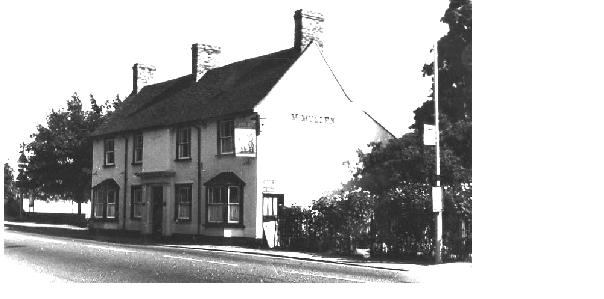
Stanstead Abbotts Local History Society

Station Road
Jolly Fisherman [No. 8 Station Road]
The Jolly Fisherman sitting comfortably between the river and the railway in the 1970’s
This Inn like the Rose and Crown developed to service the barge traffic and malting associated with the River Lea. The two Inns stood on opposite banks of the river linked by the toll bridge. Between it and the river was a malting which specialised in brown malts and there was a wharf for barges to be loaded and unloaded.
The Jolly Fisherman was known as The George in 1756, when it had stabling for eight horses. It appears to have amended its name as it is shown as The George and Dragon on a map by Robert Stephenson in 1843. It was not until about 1870 that the name was changed to the Railway Tavern nearly forty years after the railway arrived. It was variously known over the next eighty years as the Railway Tavern, Railway Inn and Railway Hotel. As the economic situation changed it moved its customer base to railway orientated business but in later years another change of name is indicative of yet another refocus to the leisure and tourism market. This last change of name occurred in 1950 when it assumed its current name of the “Jolly Fisherman”. It continues to provide service as a local hostelry under the Mc Mullen’s banner.
Licensees were recorded in the following years; 1882 Mrs Charles Webb, 1886 Charles
Massina, 1890/91 Henry Carter, 1895 James Wells, 1899 James Pitt, 1902 Herbert Wormwell,
1912/14 Charles Wigg, 1922 Albert Cotton, 1926 Arthur Faulkner, 1929-
….................
Hoddesdon Road
Crown
Earliest reference to these premises is as the Rose and Crown an Alehouse in 1756. Between 1800 and 1809 its name was shortened to the Crown, no doubt to avoid confusion with the Rose and Crown not far away across the river bridge in Stanstead Abbotts High Street. In 1805 it was acquired by the Hertford brewer Noah Young, later a free house it had previously been an Ind Coope House. The Inn was associated in people’s minds with the “house up a tree”. This was a wooden structure built within the branches of a tree located in the centre of the forecourt. The tree house was accessed by a flight of wooden steps from the Pub side of the tree. The Crown obtained a full license in 1934 and managed just to survive into the 21st century.
Licensees are recorded in the following years. 1862/6 C Jennings, 1882 Thomas Aylott,
1866-
